Over the past two years, Spliethoff has boosted its fleet with more than ten multipurpose and heavy lift vessels – the P8 and P14 series. To coincide with the additional tonnage in its roster, the shipping company undertook a study of the large bulbous bow to investigate ways to improve the operational performance and environmental impact.

Spliethoff explained: “A bulbous bow is the protruding part of the bow just below the waterline. The wave generated by this bulbous bow interferes with the wave system created by the hull, resulting in lower resistance. However, this will only happen when the vessels sail at the speed and draught range for which the bulbous bow was designed.
“Reviewing the operational profile of the vessels, the average draught was much lower than the design draught, as we mainly operate the vessels as project carriers, which do not require maximum deadweight.”
Spliethoff also operates the vessels at a lower speed than the original design, as this is another effective way of reducing the environmental impact.
To better understand the differences, a variety of operational profile model tests were performed by HSVA in Hamburg. By changing the draught, trim and speed, Spliethoff gained insights into the waves generated by the bulbous bow and the impact these had on the resistance of the vessel.
Following this, Maritime Research Institute Netherlands (MARIN) designed a new bulbous bow for Spliethoff’s intended operational profile. To validate the results, additional model tests were performed at HSVA with the new bulb design.
Once the bow’s three sub-sections were prefabricated in Dalian, China, they were fitted onto the P-Type vessel Pauwgracht. Spliethoff said it is currently evaluating the results, although this will likely require long-term monitoring.
















